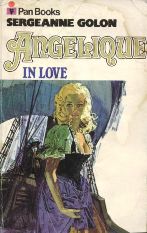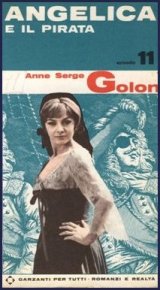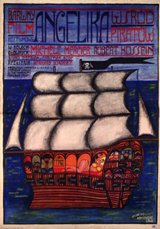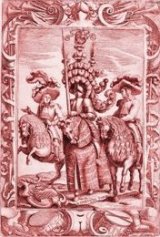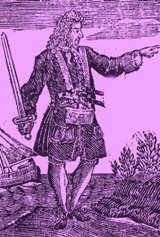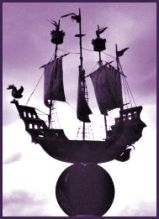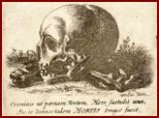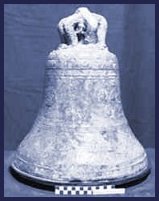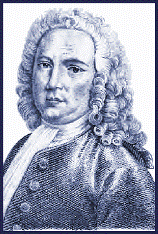Angélique in Love
'Yo ho Yo ho - A Pirate's Life for Me!'
You've all heard it - Johnny Depp has cornered the market in looking like the French Gentleman Corsair Pirate of the 17th Century and I can't wait to get stuck into this section! Follow the link to see how well Disney has portrayed his 'rascally' pirate.
Rescator
We first come across Rescator in 'Angélique and the King' when it is believed that he is responsible for the death of Cantor - the younger son born to Angélique and Joffrey de Peyrac. As she comes to terms with this tragedy, Angélique receives comfort from an unexpected quarter, from Cantor's step-father, Philippe, Marquis du Plessis-Bellière. Unfortunately that comfort is short-lived as the handsome Marquis, within a few short chapters gets his 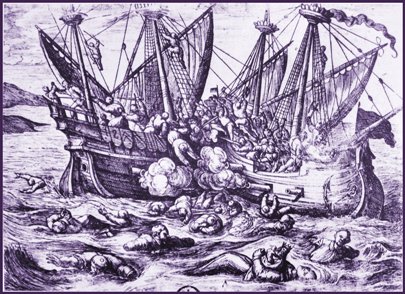 head blown off in a military skirmish. (A truly tragic end for so vain a popinjay - maybe Anne didn't like him any more than I do?) During her adventures in the Mediterranean, with amongst others that of the "Terror of the Mediterranean" d'Escrainville, Angélique finally gets to see Rescator for the first time : "'Look at the taller' (sic one), said Vivonne softly 'the one in black with a white cloak. That's he, Rescator.' ..... Angélique reached a trembling hand for Savary's telescope ..... Rescator was tall and thin and wore a black costume of a rather old-fashioned Spanish cut. ..... With a shiver, Angélique realised how closely he resembled pictures of the
Devil himself, and his whole being seemed to emanate a fascinating cruelty. So this was the man that had stood coldly by while on a sinking galley a little child raised his arms to heaven, calling for his father!"
head blown off in a military skirmish. (A truly tragic end for so vain a popinjay - maybe Anne didn't like him any more than I do?) During her adventures in the Mediterranean, with amongst others that of the "Terror of the Mediterranean" d'Escrainville, Angélique finally gets to see Rescator for the first time : "'Look at the taller' (sic one), said Vivonne softly 'the one in black with a white cloak. That's he, Rescator.' ..... Angélique reached a trembling hand for Savary's telescope ..... Rescator was tall and thin and wore a black costume of a rather old-fashioned Spanish cut. ..... With a shiver, Angélique realised how closely he resembled pictures of the
Devil himself, and his whole being seemed to emanate a fascinating cruelty. So this was the man that had stood coldly by while on a sinking galley a little child raised his arms to heaven, calling for his father!"
A 16/17th century engraving representing the tragedy of a shipwreck at the hands of pirates as may have befallen Cantor.
Later in the book Angélique meets Rescator in person after he has successfully rescued her from 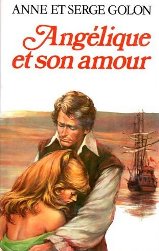 an unknown fate by 'bidding for and winning' her at a slave auction. Rather than thank him for his timely rescue of her from the predicament she had found herself in, true to previous and future form, she promptly escapes from her protector into the restricted confines of the Sultan's harem.
an unknown fate by 'bidding for and winning' her at a slave auction. Rather than thank him for his timely rescue of her from the predicament she had found herself in, true to previous and future form, she promptly escapes from her protector into the restricted confines of the Sultan's harem.
Returned home to France in disgrace, but by the grace of her sovereign King, Louis XIV, the, not to put too fine a point on it, wilful Marquise du Plessis-Bellière returns to her lands and promptly declares war on his Majesty. Following the failure of the Poitou revolt, Angélique seeks refuge in La Rochelle where she will meet Lord Rescator for the final time in 'Angélique in Love'.....
Devil, Pirate, Magician, Sorcerer
So in her mind's eye Rescator resembles the devil. D'Escrainville refers to him as a 'magician', 'sorcerer' and 'devil'. D'Escrainville no slouch himself in the ways of piracy, revelling in his own nickname of the "Terror of the Mediterranean" could therefore be seen not to have an unbiased opinion! The Duc de Vivonne, whose ship was sunk by Rescator and who had care of Cantor would not have been a great fan either - so we can assume that Rescator was probably one of the least popular characters knocking 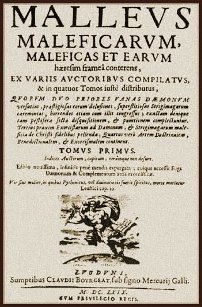 about the Mediterranean and as we discover later, the Atlantic Ocean leading to New France and New England.
about the Mediterranean and as we discover later, the Atlantic Ocean leading to New France and New England.
So how would the 'Devil' be perceived in the mid-17th Century - what would be the reference point of all good Christians? I have to admit that it was very difficult for me to find anything that would immediately bring to mind an image of Joffrey de Peyrac or Lord Rescator as the devil. Both were tall and thin and had a predilection for wearing black but to my knowledge, neither of them had horns or a tail. Indeed Angélique may well have had an over-stimulated imagination, first encouraged by her nurse in Book 1 with her tales of man-eating ogres and pirates. She also visited Mélusine (Books 1 and 5) from who she would have received an 'alternative' education, but one which would stand her in good stead when she comes to deal with the rigours of the long winters in the New World as a 'healer' and 'provisioner' of preserved foods. Her imagination would have been further stimulated on entering Joffrey's world as his wife where she took an interest in his work and came across many of the 'forbidden' books deemed inappropriate by the Catholic Church. Undoubtedly, somewhere in his library, Joffrey will have had a copy of the Malleus Maleficarum “The Hammer of the Witches” whose methods were probably used by the Church (Bécher) during Joffrey's trial to provide the proof of his guilt and subsequent allegiance to the Devil.
Francesco Maria Guazzo, author of the Malleus Maleficorum, was an Italian priest living in Milan in the 16th and 17th centuries. The 'Compendium Maleficarum', was written specifically to describe the eleven ceremonies required to participate in the Witches' Sabbath, which is a sacrilegious parody of the Catholic Mass and blasphemous in the extreme. He also offered detailed descriptions of the sexual relationships between men and incubus, women and succubus, the abhorrent, abject and abominable operations of witches against the human race and the sacred and holy remedies by which they may be neutralised. (He must have had a lot of fun researching all that!)
Here are a few images from the Malleus Maleficarum representing a variety of devils and Demons in every day situations:
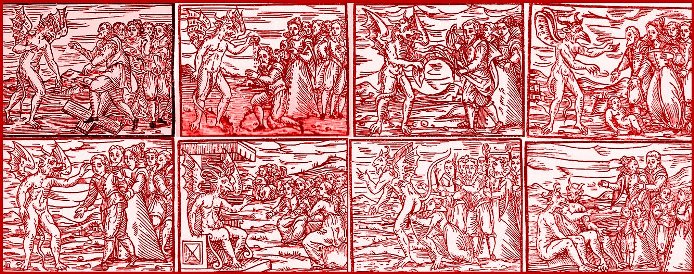
And here from the Malleus Maleficarum (inspired by Michael Psellus) is a compendium of the type of Demon to enable the accusers to identify them a positive proof:
- Demons of the superior layers of the air, which never establish a relationship with people.
- Demons of the inferior layers of the air, which are responsible for storms.
- Demons of Earth, which dwell in fields, caves and forests.
- Demons of water, which are female demons, and destroy aquatic animals.
- Demons of the underground part of the Earth, responsible of keeping hidden treasures, causing earthquakes, and causing the crumbling of houses.
- Demons of the night, which are black and evil. These demons avoid daylight.
How would these relate to major and influential characters in the books?
- I would refute the first as Angélique and Joffrey have a long and fruitful (if often interrupted) relationship with each other, their children, their friends and most of their family members - all human.
- Well, I suppose you could say both Angélique and Joffrey, conjured up many a storm in their various adventures but usually of an emotional or mischievous variety.
- Certainly Angélique could qualify here at certain times of her life - as a child in forests and marshes of Poitou, later during the Poitou uprisings she could be found there again, in Canada and the Northern United States when she first arrives and in the (currently) final book 'Victoire' where she spends an entire winter incarcerated in a forest.
- I expect Joffrey may have enjoyed fishing at some point in his life so he could perhaps qualify for the fourth reason and he will certainly have traded in beaver skins ..... but the gender issue here may prove a stumbling block!
- Number five is Joffrey all over, as Count of Toulouse, as Rescator and as Ticonderoga! In fact don't the 5 Nations refer to him as the 'Man of Thunder' because of his explosive activities - please don't point out that 'thunder' could also apply to point two or we will have to vilify him! As to his hidden treasure - Angélique? Extracting silver from porous rock? Or all that plundered pirate treasure?
- Nobody can accuse either Angélique or Joffrey of avoiding the daylight, spotlight, sunlight or any other excuse to be centre stage can they?
There are other instances of devil and witch imagery from the 17th century but much of it is similar to that portrayed in the Malleus and none of it is particularly uplifting or charming. However I want to include some specific examples which I think would have been available (to the nobility, clergy, the Jesuits, wealthy merchants and worshippers, travellers etc.) and which could have influenced peoples' imaginations.
Urbain Grandier
I cannot ignore Urbain Grandier, probably better known in association with the Devils of Loudun made infamous by Aldous Huxley and demonised on screen by Ken Russell. The images here are of Grandier himself, the pact he was supposed to have signed with the Devil and and engraving of his ultimate purge from this world.:
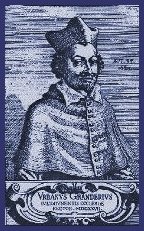
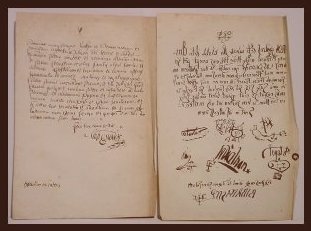

Escrainville, Jacques de Joinville (c.1664) - Knight of Malta
Not too much is known about d'Escrainville, but he did seem to enjoy most of his piratical adventures and successes with the Téméricourt brothers, of which even less is known. Interesting to see that Jacques belonged to the Knights of Malta (who were so ineffectual in snatching Angélique from the jaws of despair and that devil Rescator!)
An extract from the seafaring Knights Templar relating to trade in this time frame which would not be too far away from the concept of piracy:
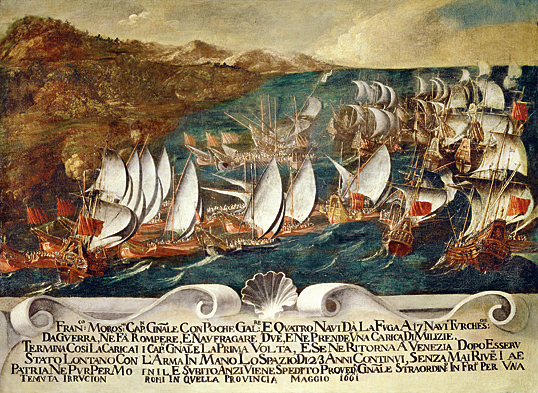
Image courtesy of Museo Correr, Venice / Erich Lessing
Relations with the Ottoman Empire were sustained by trade and punctuated by conflict. In the mid-17th century, the Turks retaliated against the Venetians for attacks on Turkish ships by the Knights Hospitaller of St. John, beginning a quarter-century of war. Depicted here is the battle which took place on 27th August 1661 in which the combined forces of Venice and Malta—22 ships—defeated a Turkish fleet of 36 galleys.
Huguenot Pirates
Stung by the contents of the Treaty of Tordesillas on the 7th of June in 1494 which declared that declared that 'lands lying beyond the Atlantic Ocean, whether discovered in the past or the future, were to be shared uniquely between Spain and Portugal' the French and English who opposed the treaty 'allowed their corsairs to attack Spanish vessels in Europe and the West Indies.'
In 1521, French privateers began a series of attacks of Spanish vessels returning from the West Indies.
Huguenot ship-owners, among others, became heavily involved in privateering, soon to be joined by their Anglican counterparts on the other side of the Channel. Their reasons for doing so were probably mercenary, but also and especially religious as this was the period of the religious wars. What the Spanish really feared was that the French Huguenots should also form colonies in "their" territory in the New World. Indeed, in 1565, under the orders of Pedro Menendez de Aviles, they had already destroyed the colony in Florida which had been founded by J.Ribault and René de Laudonière : they had slaughtered all the inhabitants "not because they were French but because they were Lutherans." Similarly, when they captured corsairs, the Spanish would treat them as heretics and sent them to the gallows, the punishment normally allocated to such a crime in Spain.
However over-archingly like an anomaly this would appear to be, considering the persecution suffered by theHuguenots in the time frame of the Angélique saga, it is of interest to note that the sailors of La Rochelle together with those of the Huguenot faith had been active as 'pirates' against the Spanish approximately 100 years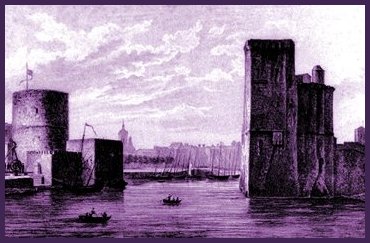 before the action in these books. Their reasons for this fully support the atrocities committed against them prior to and after the Edict of Nantes. 'Huguenot sailors who had become pirates took an active part in the war against Spain. They did this for two reasons, firstly to help defeat Spain and secondly, to support the protestant cause.'
before the action in these books. Their reasons for this fully support the atrocities committed against them prior to and after the Edict of Nantes. 'Huguenot sailors who had become pirates took an active part in the war against Spain. They did this for two reasons, firstly to help defeat Spain and secondly, to support the protestant cause.'
During the religious wars, La Rochelle became a place of retreat for the protestant armies - it soon became necessary to maintain a permanent military fleet and the corsairs were not only used to fight against the Spanish but also to bring back supplies to guarantee the survival of the armies based in La Rochelle and also to contribute to the finances of 'the (sic Protestant) cause'.
The Port of La Rochelle as it will have looked to Angélique and her protégées as they fled France for the New World.
More on the history of the Huguenot Privateers can be found on the Musee Protestant web-site.
Privateer History - French Corsairs
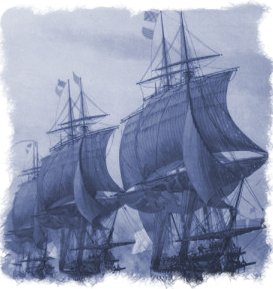 The following extract is copied, with grateful thanks from
bbprivateer.ca who knows much more than I do, but in a condensed version here there is a lot of interesting information relevant to this page.
The following extract is copied, with grateful thanks from
bbprivateer.ca who knows much more than I do, but in a condensed version here there is a lot of interesting information relevant to this page.
"Known as corsairs, French privateers plagued English & Spanish shipping for several centuries. The French considered “la course,” their word for privateering, a family business where sons followed in their fathers’ footsteps. The word "corsair" comes directly from the French word corsaire which is derived from the Latin cursus, meaning "course", as in a journey or expedition. The French word corsaire may also come as a mispronunciation of the Arabic word "corsanni", which means pirate.
For the most part, corsairs were not considered pirates but privateers working for the King of France attacking the ships of France’s enemies. In France they did not need to fear punishment for piracy, such as 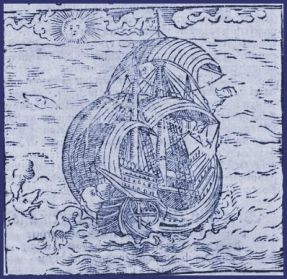 being hanged or beheaded, as they were granted a licence as combatants, known as a Lettre de Marque or Lettre de Course. This document legitimized their actions to the French justice system and also was supposed to give them the status of a war prisoner in case they were ever captured, although this was not always the case.
being hanged or beheaded, as they were granted a licence as combatants, known as a Lettre de Marque or Lettre de Course. This document legitimized their actions to the French justice system and also was supposed to give them the status of a war prisoner in case they were ever captured, although this was not always the case.
In theory, the corsair was ordered to attack only the ships of enemy countries, theoretically respecting "neutrals" and their own nation's ships. If they did not respect this rule, then they were to be treated as a pirate and hanged. The corsairs' activities also provided the King with revenue as the license required them to hand over one quarter and sometimes even one third of the booty. However, in common with privateers of other nationalities, they were often considered pirates by their foreign opponents, and could be hanged as pirates if captured by the foreigners they preyed on.
Because corsairs gained a swashbuckling reputation, the word "corsair" is also used generically as a more romantic or flamboyant way of referring to privateers, or even to pirates.
The Protestant Reformation & Rise Of The Huguenots
The Protestant Reformation, also known as the Protestant Revolt or the Reformation, was the European Christian reform movement that established Protestantism as a constituent branch of contemporary Christianity. The Catholics responded with a Counter-Reformation, led by the Jesuit order, which reclaimed large parts of Europe, such as Poland.
Protestantism spread into France, where the Protestants were nicknamed "Huguenots", and this eventually led to decades of civil warfare, where “corsairs” frequently switched sides, at first for and then later against the state as the Huguenots formed a “rebellion” or “confederation” calling for religious and political reform in France. ....
The Roman Catholic church attempted a series of propaganda campaigns, to tarnish the image of the Huguenot “Corsair“ as a marauding and lawless pirate. But in actuality, the Huguenot Corsairs were governed by a serious of 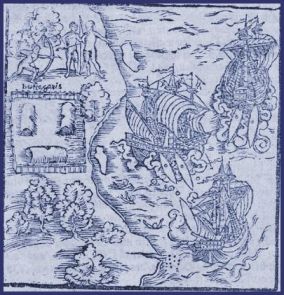 licenses issued by sympathetic protestant states – such as the Netherlands, and England.
licenses issued by sympathetic protestant states – such as the Netherlands, and England.
For several years their bases of operation included the ports of Emden (on the coast of the Dutch Province Friesland), La Rochelle (on the coast of France) and Dover (on the coast of England). The “Gueux de la mer” attacked vessels of almost any Catholic State as well as fishing villages and towns. In views of the local people, they were modern day heroes, rebelling against what was seen as a corrupt church, and for retribution against the crimes committed against the people over previous centuries by the Roman Catholic Inquisition. In the people’s eyes they were equated with the legendary knight orders such as the “Poor Knights Of Solomon” or “Knights Templar” who were also persecuted and burned at the stake in France by the King and the Pope. The Huguenots commonly were referred to as “poor” and “tramps” or beggars. At sea, they earned the nickname, “Sea Beggars”, and were seen as a heroic order, fighting for both God and the people’s rights.
An engraving of the period depicting the Corsairs being fought off
In fact, one of the common symbols of the Huguenots, known as the "Huguenot Cross" came into existence not long 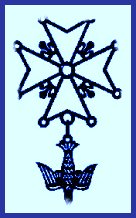 after the revocation of the Edict of Nantes in 1685. The Huguenot Cross came into general use amongst Huguenots as confirmation of the wearer's faith.
after the revocation of the Edict of Nantes in 1685. The Huguenot Cross came into general use amongst Huguenots as confirmation of the wearer's faith.
In the late 17th century, many Huguenots fled to England, the Netherlands, Prussia, Switzerland, and the overseas colonies. A significant community in France remained in the Cévennes region. A separate Protestant community, of the Lutheran faith, existed in the newly conquered province of Alsace, its status not affected by the Edict of Fontainebleau.
By the end of the 17th century, roughly 200,000 Huguenots had been driven from France during a series of religious persecutions. They relocated primarily in protestant nations: England, Switzerland, the Dutch Republic, the German Electorate of Prussia, the German Palatinate, and elsewhere in Northern Europe, as well as to what is now South Africa and to North America.
Huguenot ship-owners, among others, became heavily involved in privateering, soon to be joined by their Anglican counterparts on the other side of the Channel. Their reasons for doing so were probably mercenary, but also and especially religious : we must remember that this was heightened during the period of the religious wars. What the Spanish really feared was that the French Huguenots should also form colonies in their territory in the New World."
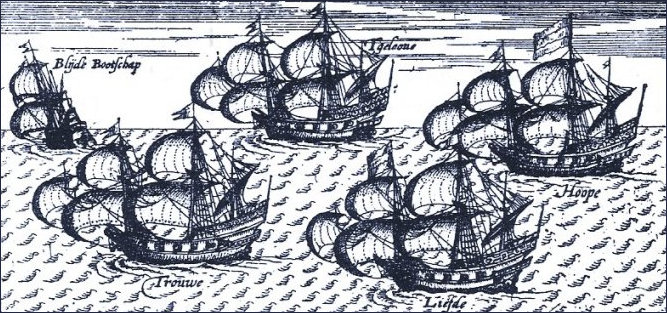
An engraving showing a fleet of Dutch ships from the 17th century
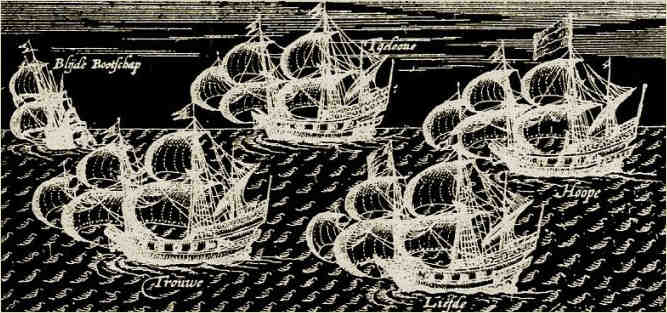
The same image in negative format to display the considerable attention to detail paid to the artwork
Post script - 21st Century
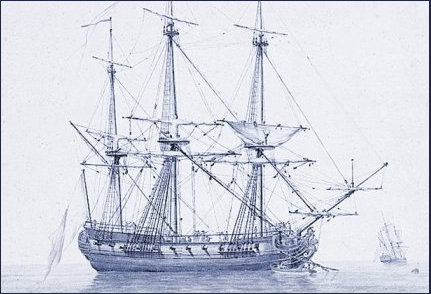
La Marquise de Tourny - Scourge of the British Navy - A painting of the French frigate from around 1780 - British Maritime Museum
From The Independent:
Found after 300 years, the scourge of the British navy
Wreck found off Plymouth is identified as feared French corsair
By Cahal Milmo - Friday 12 November 2010
Wreck found off Plymouth is identified as feared French corsair
With 25 guns and a plunder-thirsty crew, La Marquise de Tourny was the scourge of the British merchant fleet some 260 years ago. For up to a decade, the French frigate terrorized English ships by seizing their cargoes and crew under a form of state-sanctioned piracy designed to cripple British trade. Then, in the mid-18th century, the 460-ton vessel from Bordeaux, which seized three valuable cargo ships in a single year and distinguished itself by apparently never being captured by the English, disappeared without a trace. Nearly 300 years later, the fate of La Marquise and its crew can finally be revealed.
Wreckage from the frigate, including the remarkably well-preserved ship's bell carrying its name and launch date of 1744, has been found in the English Channel some 100 miles south of Plymouth by an American exploration company, suggesting that the feared privateer or "corsair" sank with the loss of all hands in a storm in notoriously treacherous waters off the Channel Islands. The vessel is the first of its type to be found off British waters and one of only three known around the world, offering a unique insight into a frenetic phase of Anglo-French warfare when both countries set about beefing up their meagre navies in the mid-1700s by providing the captains of armed merchant vessels with "Letters of Marque" to take to the seas and capture enemy ships in revenge for attacks on other cargo convoys.
The result was an escalating war of commercial attrition during which these privately-owned English and French floating raiders fought each other to a stalemate by seizing more than 3,000 vessels each in a nine year period between 1739 and 1748 as both sides sought to choke off valuable trade with their colonies in America and the West Indies. The proceeds from the sale of a single cargo could be enough to make a corsair's crew rich for life.
Dr Sean Kingsley, a British marine archaeologist who has studied the remains of La Marquise de Tourny, told The Independent: "It is a rare symbol of the mid-18th century need to fuse business with warfare at a time when naval fleets were small. Many sea captains dreamed of finding enemy ships stuffed with treasure and becoming rich beyond their wildest dreams." The wreck was first discovered by researchers working for Florida-based Odyssey Marine Exploration in 2008, but it has taken two years of painstaking archaeological detective work to conclusively establish the identity of La Marquise, not least because the site in the western end of the English Channel has been badly damaged by trawlers. Evidence such as the ship's hefty 52kg bell could now be offered on loan to French and British museums.
Odyssey, which last year announced it had also discovered nearby the remains of HMS Victory, the immediate predecessor to Admiral Nelson's flagship of the same name, has drawn criticism from some archaeologists for its excavation of wrecks and the selling of artifacts such as coins to recover its costs and fund future projects.
Odyssey argues that the site of La Marquise, where the wooden structure has been dispersed by fishing vessels and natural currents, shows that there is a race against time to examine such wrecks and retrieve whatever artifacts remain before they are destroyed. Greg Stemm, the company's chief executive, said: "Unfortunately, this type of damage has been common to virtually every site we have discovered in the English Channel. It won't be long before this site will be completely erased from history, which makes it all the more important for the private sector to step in and help with projects."
The discovery of La Marquise nonetheless casts new light on privateering. Named after the wife of the Marquis de Tourny, the royal governor of Bordeaux credited with overseeing the French port's transformation into a colonial trade hub, the frigate-style ship would have combined marauding with delivering cargo between the Americas and French Channel ports.
Archaeologists believe that the vessel, which between 1746 and 1747 alone had captured four ships and possibly took many others, was distributing a perishable cargo such as coffee or sugar when it sank. It was held up as a fine example of a corsair built for speed whose design needed to be replicated in later vessels.
The British Press hail 'Angélique in Loves' authors as 'Best-selling Partners - in Love'
An enlightening article was published in the Daily Herald as early as 1963 under the heading of 'Best Selling Partners - In Love', it's a catchy and clever title as the original article is accompanied by the hard-back edition cover of 'Angélique in Love', the 5th hardback in the series (6th in paperback format where Book 1 was divided into two). It also covers the genuine love story that brought Anne and Serge together and is reproduced in full below. The final paragraph deals with the mercenary quality of publishing a best-seller; the inevitable screen 'adaptation' (that usually omits the richness of the writing and the plots and misses out on the nuances that make such riveting reading), the proposal of a 'perfume' by fashion 'influencer' Cassini and for those of us interested in everything else a really engaging tale of how the characters are kept 'in line' to ensure not only continuity, but to avoid any 'faux pas' due to carelessness or errors, because judging by today's standards and the way 'Line of Duty' is being ripped apart to 'solve the mystery of H' they really had to be on their toes to keep ahead of the 'massive number of fans' who kept writing in to point out transgressions - imagine social media today!

Her flashing, emerald-green eyes drive men to deeds of unheard-of gallantry, her blonde hair trails through adventure after adventure, each more exotic and exciting than the last. Such is Angélique, the intrepid, passionate and always enchanting heroine of the most fantastically successful series of historical romances ever written. The latest episode, 'Angélique In Love', was published in Britain a few days ago* by Heinemann. The hard statistics will bring tears of envy to most authors. For every time Russian born Serge Colon and his charming French wife Anne sit down in their "writing laboratory " they know that the book they are about to produce under the name Sergeanne Golon will sell at least a million copies. The love affairs and adventures of Angélique. draped round with the rich historical tapestry of 17th century France. have been avidly soaked up by more than 35 million people In 15 countries. Even the Russians want to publish Angélique. And some touch negotiations are going on with the Japanese.
Angélique may be a romance, but there is nothing romantic about the way the Golons put her on paper in their chalet in the Swiss Alps. Middle-aged Anne and Serge - wealthy after six volumes - plan how Angélique shall fall into the clutches of the Hungarian princes, French noblemen, robber chiefs and pirates, and almost into the embraces of Louis XIV himself, with military precision.
Labelled
Each character is neatly labelled on matchsticks and planted into plasticine. As he is run through by a sword or abandoned by Angélique, the matchstick is removed and placed in trays labelled with his fate. For their first Angélique novel. the Golons spent a year at Versailles and read more than 300 manuscripts on 17th Century France. They drew up plans, graphs, made notes, and carefully worked out every character, scene and chapter in advance. They then got to work, with Serge writing one scene and his wife writing another. "Our styles are so similar" say the couple, "that where one leaves off, the other picks up the thread naturally." "For us, writing together is like singing a song with two voices." says Serge. "We never have a row or disagree. We have created Angélique together - scientifically and psychologically - so that she would just be what was wanted. "We study each character from two points of view : my wife sees the woman's side and I see the man's side." Everything in their books is authentic - even the characters. For apart from Angélique herself and one or two others, every person mentioned in the series has his or her real place in history.
In France, where the novels first appear, people are proud of their historical knowledge - and even a small error will bring letters in their wrathful hundreds. Although their method of writing is cold and clinical, the Golons - parents of four young children - have romantic lives.
Refugee
Serge, who was a refugee in the Crimea after the Russian revolution, found himself in a Turkish prison. He arrived in Marseilles with nothing in his pockets but a heavy revolver and 250 rounds of ammunition. A top-level mining expert, he became a prospector in China, Burma, India and Siam before making for Africa. And it was in the Congo where he met his future wife, Anne - a successful journalist who had won a literary prize, and was using the money to visit Africa. She heard about Serge and decided to interview him. He married her . .
Then came trouble for white settlers in France's African colonies. The couple had to leave — and arrived penniless in Paris.
Perfume
Then they hit on the Idea of Angélique. That was seven years ago and the Golons have never looked back. The adventures of Angélique are serialised in newspapers and magazines. Perfume, a record, dress styles, cosmetics and even furniture have been sold under the name of "Angélique " — all of course, paying the Golons. Now a film is being planned. The couple work so hard at producing their books each is some 700 to 800 pages - that they are, perhaps, a little tired of Angélique. But so massive is their fan mail, demanding to know what next happens to their heroine, that they dare not stop. So out come the charts, the matches planted in plasticine, the graphs — and from a literary test-tube In the Alps comes another Angélique adventure. And the pound notes, the dollars. the francs, the lira. drachma, yen - and maybe even roubles — come rolling in. Source : The Daily Herald - *Tuesday 27th August 1963 via the British Newspaper Archive
Page refreshed : 10th May 2021 (G)

